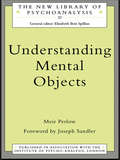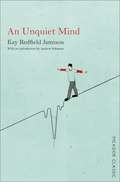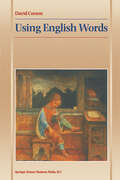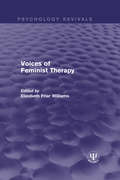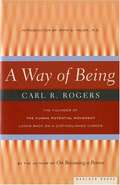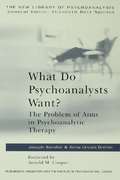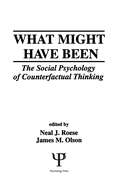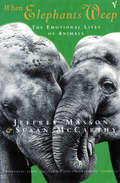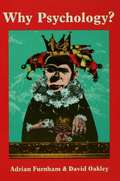- Table View
- List View
Understanding Mental Disorders Due To Medical Conditions Or Substance Abuse: What Every Therapist Should Know
by Ghazi AsaadThis text is a unique handbook that will heighten the awareness of all mental health professionals and students toward organic factors in mental illness.
Understanding Mental Objects (The New Library of Psychoanalysis #Vol. 22)
by Meir PerlowThe ways in which an individual (the subject) relates to and perceives other people (his or her 'objects') has always been a preoccupation of psychoanalysis and in recent years a plethora of concepts has grown up in the literature. In this ground-breaking study, Meir Perlow sets out to clarify the changing meanings of the different concepts from context to context, discussing in depth the theoretical issues underlying them. The book begins with an historical survey of how mental objects have been understood in the various 'schools' of psychoanalysis as they have developed. These include Freud and his associates, the object-relations approaches of Klein, Fairbairn and Bion, orientations derived from ego psychology such as those of Schafer and Kernberg, and the self orientation of Winnicott and Kohut. In Part Two the author discusses the conceptual and clinical issues involved in the major differences between the concepts. Finally, in Part Three he delineates three basic meanings of the concepts of mental objects as they have emerged in the literature and shows how they are related to ongoing issues in contemporary psychoanalysis. This long overdue clarification of a complex area, with its wide ranging and imaginative grasp of the different theories about objects, will be an invaluable reference for all psychoanalysts and psychologists.
Understanding Mental Objects (The New Library of Psychoanalysis)
by Meir PerlowThe ways in which an individual (the subject) relates to and perceives other people (his or her 'objects') has always been a preoccupation of psychoanalysis and in recent years a plethora of concepts has grown up in the literature. In this ground-breaking study, Meir Perlow sets out to clarify the changing meanings of the different concepts from context to context, discussing in depth the theoretical issues underlying them. The book begins with an historical survey of how mental objects have been understood in the various 'schools' of psychoanalysis as they have developed. These include Freud and his associates, the object-relations approaches of Klein, Fairbairn and Bion, orientations derived from ego psychology such as those of Schafer and Kernberg, and the self orientation of Winnicott and Kohut. In Part Two the author discusses the conceptual and clinical issues involved in the major differences between the concepts. Finally, in Part Three he delineates three basic meanings of the concepts of mental objects as they have emerged in the literature and shows how they are related to ongoing issues in contemporary psychoanalysis. This long overdue clarification of a complex area, with its wide ranging and imaginative grasp of the different theories about objects, will be an invaluable reference for all psychoanalysts and psychologists.
The Understanding of Causation and the Production of Action: From Infancy to Adulthood (Essays in Developmental Psychology)
by Peter Anthony WhiteThis text is an attempt to trace out a line of development in the understanding of how things happen, from origins in infancy to mature forms in adulthood. There are two distinct but related ways in which people understand things as happening, denoted by the terms "causation" and "action". This book is concerned with both.; The central claim and organizing principle of the book is that, by the end of the second year of life, children have differentiated two core theories of how things happen. These theories deal with causation and action. The two theories have a common point of origin in the infant's experience of producing actions, but thereafter diverge, both in content and in realm of application. Once established, the core theories of causation and action never change, but form a permanent metaphysical underpinning on which subsequent developments in the understanding of how things happen are erected. The story of development is therefore largely the story of how further concepts become attached to integrated with the core theories. Although the developmental and adult literatures on causal understanding appear at first glance to have little in common, in fact this appearance is illusory, and the idea of two theories helps to bring the two literatures in contact with each other.; The book begins with a survey of the main philosophical ideas about causation and action. Following this, the possible origins of understanding in infancy are reviewed, and separate chapters then deal with the development of understanding of action and causation through childhood. This is then linked to the adult understanding of action and causation, and the literature on adult causal attribution and causal judgement is reviewed from this perspective.
The Understanding of Causation and the Production of Action: From Infancy to Adulthood (Essays in Developmental Psychology)
by Peter Anthony WhiteThis text is an attempt to trace out a line of development in the understanding of how things happen, from origins in infancy to mature forms in adulthood. There are two distinct but related ways in which people understand things as happening, denoted by the terms "causation" and "action". This book is concerned with both.; The central claim and organizing principle of the book is that, by the end of the second year of life, children have differentiated two core theories of how things happen. These theories deal with causation and action. The two theories have a common point of origin in the infant's experience of producing actions, but thereafter diverge, both in content and in realm of application. Once established, the core theories of causation and action never change, but form a permanent metaphysical underpinning on which subsequent developments in the understanding of how things happen are erected. The story of development is therefore largely the story of how further concepts become attached to integrated with the core theories. Although the developmental and adult literatures on causal understanding appear at first glance to have little in common, in fact this appearance is illusory, and the idea of two theories helps to bring the two literatures in contact with each other.; The book begins with a survey of the main philosophical ideas about causation and action. Following this, the possible origins of understanding in infancy are reviewed, and separate chapters then deal with the development of understanding of action and causation through childhood. This is then linked to the adult understanding of action and causation, and the literature on adult causal attribution and causal judgement is reviewed from this perspective.
UniSIM Reader for Cross-cultural Intelligence
by Sage SageSSC263 Cross-Cultural Intelligence is primarily concerned with the ways in which an individual may come to understand the nuances of an unfamiliar culture (i.e., a culture other than his or her own). It aims to develop in students an appreciation of the unfamiliar culture’s values, norms and beliefs on its own terms by teaching them to compare and contrast the similarities and differences between an unfamiliar culture and his or her own culture, as well as between two or more unfamiliar cultures. In a broader sense, it aims to enable students to take the appropriate steps to dismantle the barriers to intercultural communication, intelligently adapt to unfamiliar cultural settings, manage conflicts and behave appropriately and according to the cultural and social contexts so as to function effectively within unfamiliar cultural contexts and build lasting relationships with people from a different culture.
An Unquiet Mind: A Memoir of Moods and Madness (Picador Collection #130)
by Kay Redfield JamisonAn Unquiet Mind is a definitive examination of manic depression from both sides: doctor and patient, the healer and the healed. A classic memoir of enormous candour and courage, it teems with the wit and wisdom of its writer, Dr Kay Redfield Jamison.With an introduction by Andrew Solomon, writer and lecturer on psychology and culture.'It stands alone in the literature of manic depression for its bravery, brilliance and beauty.' – Oliver SacksI was used to my mind being my best friend. Now, all of a sudden, my mind had turned on me: it mocked me for my vapid enthusiasms; it laughed at all of my foolish plans; it no longer found anything interesting or enjoyable or worthwhile.Dr Kay Redfield Jamison is one of the foremost authorities on manic depression (bipolar disorder) – and has experienced its terrors and cruel allure first-hand. While pursuing her career in medicine, she was affected by the same exhilarating highs and catastrophic lows that afflicted many of her patients. From her jubilant childhood to the disquiet that has dominated her adult life, she charts a journey through her own mind, and those of others.
The Uses Of Autobiography
by Julia SwindellsFirst Published in 1995. Routledge is an imprint of Taylor & Francis, an informa company.
The Uses Of Autobiography
by Cambridge. Julia Swindells Homerton College, Cambridge.First Published in 1995. Routledge is an imprint of Taylor & Francis, an informa company.
Using English Words
by P. CorsonUsing English Words examines the impact that the life histories of people have on their vocabulary. Its starting point is the taken-for-granted fact that the vocabulary of English falls into two very different sections. Randolph Quirk mentions this striking incompatibility between the Anglo Saxon and the Latinate elements in English: "the familiar homely-sounding and typically very short words" that we learn very early in life and use for most everyday purposes; and "the more learned, foreign-sounding and characteristically rather long words" (1974, p. 138). It is mainly the second type of word that native speakers start learning relatively late in their use of English, usually in the adolescent years of education, and keep on learning. It is mainly the one type of word, rather than the other, that ESL/ EFL students have more difficulty with, depending on their language background. This book shows how discursive relations, outside education, 'position' people through their vocabularies. Some are prepared for easy entry into lifetime prospects of relative privilege and educational success, while others are denied entry. In writing this book, I share an aim with other writers who observe the many discontinuities that exist between discursive practices in communities outside schools, and the discursive demands that schools make (e. g. Hamilton et a1. [19931, Heath [1983], Luke [19941, Philips [1983], Romaine [1984], Scollon & Scollon [1981]).
The Varieties of Orthographic Knowledge: II: Relationships to Phonology, Reading, and Writing (Neuropsychology and Cognition #11)
by Virginia WiseBerningerThe role of orthography in reading and writing is not a new topic of inquiry. For example, in 1970 Venezky made a seminal contribution with The Structure of English Orthography in which he showed how both sequential redundancy (probable and permissible letter sequences) and rules of letter-sound correspondence contribute to orthographic structure. In 1972 Kavanagh and Mattingly edited Language by Eye and by Ear which contained important linguistic studies of the orthographic system. In 1980 Ehri introduced the concept of orthographic images, that is, the representation of written words in memory, and proposed that the image is created by an amalgamation of the word's orthographic and phonological In 1981 Taylor described the evolution of properties. orthographies in writing systems-from the earliest logographies for pictorial representation of ideas to syllabaries for phonetic representation of sounds to alphabets for phonemic representation of sounds. In 1985 Frith proposed a stage model for the role of orthographic knowledge in development of word recognition: Initially in the logographic stage a few words can be recognized on the basis of partial spelling information; in the alphabetic stage words are recognized on the basis of grapheme-phoneme correspondence; in the orthographic stage spelling units are recognized automatically without phonological mediation. In 1990 Adams applied connectionism to an analysis of the orthographic processing of skilled readers: letter patterns emerge from the association units linking individual letters.
Verstehen und Verständlichkeit: Eine psycholinguistische Studie zum Verstehen von Führungsgrundsätzen in Wirtschaftsunternehmen
by Susanne KleinThe Visible and Invisible Group: Two Perspectives On Group Psychotherapy And Group Process (The\international Library Of Group Psychotherapy And Group Process)
by Yvonne M. AgazarianUnderstanding the psychodynamics of groups has derived from the two separate strands of theory and practice, resulting in two separate disciplines: group psychotherapy and group dynamics. Present-day group psychotherapy derives mainly from psychoanalytic theory and Bion's early experiences with wartime groups, and has been developed from the work of clinicians who practice group psychotherapy as a form of treatment. Group dynamics theory and practice, on the other hand, have arisen largely from the work of social scientists like Kurt Lewin, have been researched in the field and in the laboratory, and have been applied to groups as arenas for leadership training and behavioral change. The Visible and Invisible Group synthesizes these psychoanalytic and group approaches to group life and offers practical guidelines to the group psychotherapist. The authors advocate the simultaneous use of two perspectives: the psychoanalytic perspective for observing the "visible" group of people and their interactions, and a General Systems "Field Theory" perspective for observing the "invisible" group-as-a-whole.
The Visible and Invisible Group
by Yvonne M. AgazarianUnderstanding the psychodynamics of groups has derived from the two separate strands of theory and practice, resulting in two separate disciplines: group psychotherapy and group dynamics. Present-day group psychotherapy derives mainly from psychoanalytic theory and Bion's early experiences with wartime groups, and has been developed from the work of clinicians who practice group psychotherapy as a form of treatment. Group dynamics theory and practice, on the other hand, have arisen largely from the work of social scientists like Kurt Lewin, have been researched in the field and in the laboratory, and have been applied to groups as arenas for leadership training and behavioral change. The Visible and Invisible Group synthesizes these psychoanalytic and group approaches to group life and offers practical guidelines to the group psychotherapist. The authors advocate the simultaneous use of two perspectives: the psychoanalytic perspective for observing the "visible" group of people and their interactions, and a General Systems "Field Theory" perspective for observing the "invisible" group-as-a-whole.
Vision and Mind: Modeling Mental Functions
by Vadim D. GlezerThe usual method for studying mental processes entails taking words in linguistics -- or concepts in logic -- and establishing the connections and relationships between them. Thus, the traditional approach to semantic problems -- those of meaning and understanding -- is through language. Most researchers agree that thought and language are generated by deep-seated semantic structures determined by the structure of the brain. Until now, however, all attempts at constructing semantic models have been made on the basis of linguistic material alone, without taking brain structure into account. Analysis of these models shows them to be as inadequate as those based on the method of the black box. This book approaches the problem of the organization of higher psychological functions a different way -- by analyzing the functional organization of the neural structures that gradually form universal categories from "raw" sensory material. At the higher levels of the brain's operation, these universals correspond to the basic categories of thought and language. The visual system provides rewarding material for such an approach, both because it is relatively well researched and because it is the main source of sensory information in humans. With this in mind, this monograph examines the whole process of the transformation and description -- the coding of visual information. The most important aspect of this process is the transition from the description of visual space to the description of individual objects and the relationships between them. This transition is made possible by the existence in the visual system of various mechanisms that developed during evolution as a result of environmental influences. Written for a wide circle of investigators in disciplines associated with different aspects of the functioning of the brain -- physiologists and psychologists -- this book is also of importance to engineers and mathematicians working on the problems of artificial intelligence, and linguists and philosophers interested in the deep structures that form the universals of thought and language.
Vision and Mind: Modeling Mental Functions
by Vadim D. GlezerThe usual method for studying mental processes entails taking words in linguistics -- or concepts in logic -- and establishing the connections and relationships between them. Thus, the traditional approach to semantic problems -- those of meaning and understanding -- is through language. Most researchers agree that thought and language are generated by deep-seated semantic structures determined by the structure of the brain. Until now, however, all attempts at constructing semantic models have been made on the basis of linguistic material alone, without taking brain structure into account. Analysis of these models shows them to be as inadequate as those based on the method of the black box. This book approaches the problem of the organization of higher psychological functions a different way -- by analyzing the functional organization of the neural structures that gradually form universal categories from "raw" sensory material. At the higher levels of the brain's operation, these universals correspond to the basic categories of thought and language. The visual system provides rewarding material for such an approach, both because it is relatively well researched and because it is the main source of sensory information in humans. With this in mind, this monograph examines the whole process of the transformation and description -- the coding of visual information. The most important aspect of this process is the transition from the description of visual space to the description of individual objects and the relationships between them. This transition is made possible by the existence in the visual system of various mechanisms that developed during evolution as a result of environmental influences. Written for a wide circle of investigators in disciplines associated with different aspects of the functioning of the brain -- physiologists and psychologists -- this book is also of importance to engineers and mathematicians working on the problems of artificial intelligence, and linguists and philosophers interested in the deep structures that form the universals of thought and language.
Voices of Feminist Therapy (Psychology Revivals)
by Elizabeth Friar WilliamsFeminist therapy was created in the late 1960s, concurrent with the founding of The Association for Women in Psychology. Its early practitioners had diverse lifestyles, backgrounds, and often unconventional training, but all had a common and radical goal of providing an alternative therapy for women whose mental health was still defined in terms of male-pleasing behaviours and rigid social roles. Originally published in 1995, the contributors share the personal experiences and reflections that helped them revolutionize therapy for women, particularly poignant and instructive at the time, as psychotherapy evolved from client-centred and individualistic to bureaucratic and socially and politically conservative.
Voices of Feminist Therapy (Psychology Revivals)
by Elizabeth Friar WilliamsFeminist therapy was created in the late 1960s, concurrent with the founding of The Association for Women in Psychology. Its early practitioners had diverse lifestyles, backgrounds, and often unconventional training, but all had a common and radical goal of providing an alternative therapy for women whose mental health was still defined in terms of male-pleasing behaviours and rigid social roles. Originally published in 1995, the contributors share the personal experiences and reflections that helped them revolutionize therapy for women, particularly poignant and instructive at the time, as psychotherapy evolved from client-centred and individualistic to bureaucratic and socially and politically conservative.
A Way Of Being (PDF)
by Carl Rogers Irvin D. Yalom Carl Ransom RogersA Way of Being was written in the early 1980s, near the end of Rogers' career, and serves as a coda to his classic On Becoming a Person. More philosophical than his earlier writings, it traces his professional and personal development. Rogers concludes by predicting a more humane future
What Do Psychoanalysts Want?: The Problem of Aims in Psychoanalytic Therapy (The New Library of Psychoanalysis)
by Anna Ursula Dreher Joseph SandlerDefining the aims of psychoanalysis was not initially a serious complex problem. However, when Freud began to think of the aim as being one of scientific research, and added the different formulations of aim (for example, that the aim was to make the patient's unconscious conscious) it became an area of tension which affected the subsequent development of psychoanalysis and the resolution of which has profound implications for the future of psychoanalysis. In What Do Psychoanalysts Want? the authors look at the way psychoanalysts have defined analysis both here and in America, from Freud down to the present day. From this basis they set out a theory about aims which is extremely relevant to clinical practice today, discussing the issues from the point of view of the conscious and unconscious processes in the psychoanalyst's mind. Besides presenting a concise history of psychoanalysis, its conflicts and developments, which will be of interest to a wide audience of those interested in analysis, this book makes important points for the clinician interested in researching his or her practice.
What Do Psychoanalysts Want?: The Problem of Aims in Psychoanalytic Therapy (The New Library of Psychoanalysis #No.24)
by Anna Ursula Dreher Joseph SandlerDefining the aims of psychoanalysis was not initially a serious complex problem. However, when Freud began to think of the aim as being one of scientific research, and added the different formulations of aim (for example, that the aim was to make the patient's unconscious conscious) it became an area of tension which affected the subsequent development of psychoanalysis and the resolution of which has profound implications for the future of psychoanalysis. In What Do Psychoanalysts Want? the authors look at the way psychoanalysts have defined analysis both here and in America, from Freud down to the present day. From this basis they set out a theory about aims which is extremely relevant to clinical practice today, discussing the issues from the point of view of the conscious and unconscious processes in the psychoanalyst's mind. Besides presenting a concise history of psychoanalysis, its conflicts and developments, which will be of interest to a wide audience of those interested in analysis, this book makes important points for the clinician interested in researching his or her practice.
What Might Have Been: The Social Psychology of Counterfactual Thinking
by Neal J. Roese James M. OlsonWithin a few short years, research on counterfactual thinking has mushroomed, establishing itself as one of the signature domains within social psychology. Counterfactuals are thoughts of what might have been, of possible past outcomes that could have taken place. Counterfactuals and their implications for perceptions of time and causality have long fascinated philosophers, but only recently have social psychologists made them the focus of empirical inquiry. Following the publication of Kahneman and Tversky's seminal 1982 paper, a burgeoning literature has implicated counterfactual thinking in such diverse judgments as causation, blame, prediction, and suspicion; in such emotional experiences as regret, elation, disappointment and sympathy; and also in achievement, coping, and intergroup bias. But how do such thoughts come about? What are the mechanisms underlying their operation? How do their consequences benefit, or harm, the individual? When is their generation spontaneous and when is it strategic? This volume explores these and other numerous issues by assembling contributions from the most active researchers in this rapidly expanding subfield of social psychology. Each chapter provides an in-depth exploration of a particular conceptual facet of counterfactual thinking, reviewing previous work, describing ongoing, cutting-edge research, and offering novel theoretical analysis and synthesis. As the first edited volume to bring together the many threads of research and theory on counterfactual thinking, this book promises to be a source of insight and inspiration for years to come.
What Might Have Been: The Social Psychology of Counterfactual Thinking
by Neal J. Roese James M. OlsonWithin a few short years, research on counterfactual thinking has mushroomed, establishing itself as one of the signature domains within social psychology. Counterfactuals are thoughts of what might have been, of possible past outcomes that could have taken place. Counterfactuals and their implications for perceptions of time and causality have long fascinated philosophers, but only recently have social psychologists made them the focus of empirical inquiry. Following the publication of Kahneman and Tversky's seminal 1982 paper, a burgeoning literature has implicated counterfactual thinking in such diverse judgments as causation, blame, prediction, and suspicion; in such emotional experiences as regret, elation, disappointment and sympathy; and also in achievement, coping, and intergroup bias. But how do such thoughts come about? What are the mechanisms underlying their operation? How do their consequences benefit, or harm, the individual? When is their generation spontaneous and when is it strategic? This volume explores these and other numerous issues by assembling contributions from the most active researchers in this rapidly expanding subfield of social psychology. Each chapter provides an in-depth exploration of a particular conceptual facet of counterfactual thinking, reviewing previous work, describing ongoing, cutting-edge research, and offering novel theoretical analysis and synthesis. As the first edited volume to bring together the many threads of research and theory on counterfactual thinking, this book promises to be a source of insight and inspiration for years to come.
When Elephants Weep: The Emotional Lives of Animals (Large Print Bks.)
by Jeffrey Masson Susan McCarthyFor more than 100 years, scientists have denied that animals experience emotions, yet this remarkable and groundbreaking book proves what animal-lovers have known to be true: wolves, tigers, giraffes, elephants and many other creatures exhibit all kinds of feelings - hope, fear, shame, love, compassion. From Ola, the irritable whale, to Toto, the chimpanzee who nursed his owner back to health, this book collects together for the first time a vast range of case histories which show the extraordinary complexity of the animal world, and the tumult of emotions that govern it.
Why Psychology?
by Adrian Furnham David OakleyPsychology has been the fastest growing student discipline in recent years and in Why Psychology? the unique essence, attraction and diversity of the subject is introduced for the uninitiated in an accessible and attractive way. It will be suitable for school students considering studying psychology in college or university, for those considering a change in career, for parents, careers officers and others who advise students of all ages. It will also be required reading for anyone who has ever wondered just what psychology involves but was not sure where to find out. Why Psychology? will be the starting point for a whole generation of new psychologists at the stage where they are asking the fundamental question about their academic future -- which subject should I study? It provides an intelligent and accessible answer as to why psychology might be for them. What it means to study and practise psychology is explained in this introduction to an often misunderstood field. It provides a broad view of the scope of psychology and shows its rich diversity and depth in an accessible introductory style. The book is intended for "A"-level students considering their degree options; careers advisors; degree-level students with a subsidiary choice to make; and general low-level psychology market.

